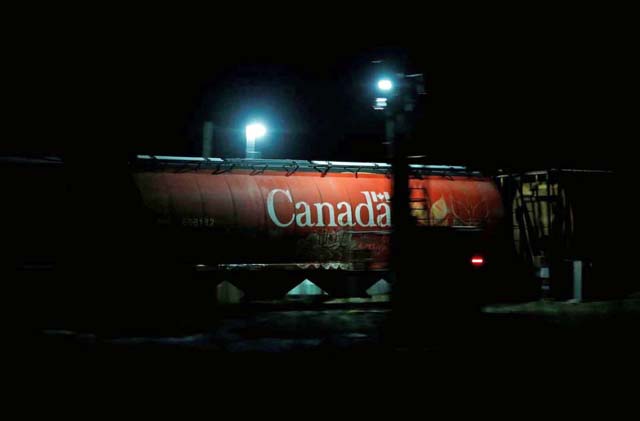

Not Well Used by Shippers
Western Canada - A new report produced by Canada's Grain Monitoring Program suggests that fewer than 4,800 cars of western Canadian grain, less
than one percent of the country's total grain movements, were moved under Ottawa's extended railway interswitching provisions in 2015-2016.
The report also suggests that only 13 licensed elevators in Western Canada used the extended interswitching provisions out of the 339 eligible
elevators.
Extended interswitching was one of the key provisions contained in the Fair Rail for Grain Farmers Act, which came into effect in 2014.
The act was passed in response to a system-wide bottleneck that choked off country grain deliveries, left prairie elevators plugged, and caused widespread
congestion in Western Canada's grain export channels.
In early 2014, railway interswitching distances in Manitoba, Saskatchewan, and Alberta were extended to 160 from 30 kilometres.
The extension meant that grain shippers, including large elevator companies, could have moved loaded grain cars up to 160 kilometres on one railway and then
switched to the lines of another railway carrier for the remainder of the haul.
The provisions were open to all shippers located within 160 kilometres of a recognized railway interswitch location.
The purpose of the provision was to provide grain shippers with improved access to alternative railway services, particularly in light of the system-wide
logistical problems that were encountered in 2013-2014.
In theory, about 339 of the 370 western elevators that were licensed in 2015-2016 (about 90 percent) could have used the provisions.
However, "practical commercial considerations limited the potential application of this reach to about 150 locations," the Grain Monitoring Program
report said.
"In the end, only 13 of these facilities would report use of this provision in moving traffic."
Of the roughly 4,800 grain cars that were moved under interswitching, more than 3,600 (76 percent) saw Canadian National Railway or Canadian Pacific Railway
move grain cars for the U.S.-based rail carrier Burlington Northern Sante Fe.
In aggregate, shippers that used the extended interswitching saved an estimated $5.3 million in conventional freight charges, either through more competitive
freight rates or shorter transit routes.
Interswitching aside, the Grain Monitoring Program report suggested that Canada's Class 1 railway companies are becoming more efficient at moving western
Canadian grain.
However, the efficiency gains realized over the past few years were largely the result of CN and CP moving longer trains from main-line elevator locations and
offering freight discounts for large block movements.
For example, nearly 80 percent of the grain that was delivered by farmers in the 2015-2016 crop year moved through 97 elevators.
In the same year, nearly 86 percent of the western grain moved by rail was moved in blocks of 50 cars or more, and nearly 32 million tonnes of grain that was
moved by rail qualified for large block freight discounts.
Rationalization of Western Canada's rail and elevator systems has fundamentally altered the way grain is moved in the West.
For example, the number of Class D facilities, the largest grain handling facilities in Western Canada, had increased to 135 by mid-2016 from 38 in
1999.
Class D facilities have railway sidings or loop tracks that can accommodate 100 or more grain cars.
By comparison, the number of Class A facilities (those that can handle 25 cars or less) fell to 132 from 705 in 1999.
Class B facilities (25 to 49 cars) dropped to 49, down from 180 in 1999, and Class C facilities (50 to 99 cars) dropped to 67 from 81.
The closure of smaller, less efficient elevators, means prairie farmers are trucking grain longer distances on municipal and provincial road
systems.
It has also allowed railways to improve key railway performance measurements such as loaded transit times and car cycle times.
Average loaded transit times of loaded grain cars reached an all-time low of 4.8 days in 2015-2016, and car cycle times dropped to an average of 13.3 days, the
Grain Monitoring Program report said.
Car cycle time is the time required by a rail carrier to deliver a loaded grain car from its point of origin to its destination and then return an empty car
back to a prairie delivery point for reloading.
Brian Cross.
of the Canadian Copyright Modernization Act.


